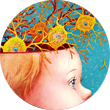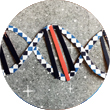
This year, researchers made big headway on autism’s most perplexing questions.
In some of the largest genetics studies to date, scientists combed the genomes of hundreds of thousands of participants to decipher the role of common variants in autism. Some teams explored new angles on autism’s sex bias: for example, in microglia (the brain’s immune cells) and in camouflaging (a pervasive behavior in which women and girls mask their autism traits).
Here are five of the hottest topics in autism research in 2018.
 Protein synthesis
Protein synthesis
Scientists have long suspected that the neurons in people with fragile X syndrome overproduce proteins and that this overproduction is at the root of the condition. They have also assumed that protein synthesis is at the heart of a related condition called tuberous sclerosis complex (TSC).
But this year, some studies called these long-established beliefs into question.
Fragile X syndrome is caused by mutations in the FMR1 gene that prevent production of the corresponding protein, FMRP. Several studies suggested that FMRP tamps down the production of other proteins. People missing FMRP may thus have an excess of proteins in their cells.
But one new study suggests that this may be true in only some people with fragile X syndrome. The levels of protein production vary widely among people with the condition, and some have levels comparable to that of controls. This suggests that the effect on protein synthesis may not fully explain the features of fragile X. Another study in fruit flies hints that FMRP facilitates the production of proteins — rather than hindering it.
In TSC, too, the problem might be too little protein rather than too much, according to a study published in January. That study found that mice with a mutation linked to TSC make too little protein. This finding surprised the researchers because the mutation had been thought to ramp up protein synthesis.
 Camouflaging
Camouflaging
Three to four times as many boys as girls are diagnosed with autism, and researchers suspect that this may be because some girls — and women — ‘camouflage’ their autism traits.
Camouflaging is more than an attempt to fit in: It involves a persistent, and sometimes exhausting, effort to repress certain traits or alter how one acts. This effort is less common in men on the spectrum. Camouflaging may explain why some girls appear to have more severe autistic features than boys early on: Many girls may camouflage their traits well enough to avoid getting picked up by diagnostic tests, so only the ones who are severely affected end up being diagnosed.
This year, researchers made moves to quantify camouflaging by building a 25-item test called the Camouflaging Autistic Traits Questionnaire. Other teams focused on the biological underpinnings of camouflaging. In one study, for instance, researchers reported that activity in a ‘social’ brain region called the ventromedial prefrontal cortex tracks with women’s scores on a set of tests that measure camouflaging.
 Sex differences
Sex differences
Researchers made other strides into understanding autism’s sex bias.
Two studies looked at sex differences in the brain’s immune cells, or microglia, which respond to infection by clearing the brain of debris and pathogens. In one study, researchers studied mice that lack a microbiome — the body’s community of microbes.
Male fetal mice have a higher density of microglia than controls do, and these microglia show altered gene expression. But this pattern changes in adulthood, with female mice showing differences relative to controls.
In the second study, researchers found that microglia in male mice express higher levels of genes involved in inflammation than females do. Together, the papers hint that microglia have sex-specific features — but why these differences exist is still unclear.
Some studies also refined the picture of social and behavioral differences in boys and girls with autism. For instance, a large study of children from nine countries found that autistic girls aged 5 and younger have less severe restricted and repetitive behaviors than young autistic boys do.
And a pair of studies on social communication suggest that girls may have more social-communication impairments than boys as they near adolescence. One of the studies shows that at around age 7, girls have fewer social problems than boys do, but those problems worsen by age 16. The second study suggests that girls with autism have more trouble playing in groups and smiling than autistic boys do, perhaps because the bar for social success is higher in girls.
 Serotonin
Serotonin
This year marked a resurgence of interest in the link between autism and the chemical messenger serotonin.
One in three autistic people has elevated serotonin levels in the blood. Although decades of studies have attempted to clarify the link between serotonin and autism, they have mostly come up short. For instance, in clinical trials, antidepressants that boost serotonin levels seem to do little to relieve autism’s core traits.
Two 2018 studies offer one explanation for these disappointing findings: Antidepressants may increase serotonin levels too slowly to make a difference.
In one study, researchers found that a drug that rapidly increases serotonin levels in a mouse model of autism makes them more sociable; blocking serotonin receptors negates this effect. Another study linked low maternal serotonin levels to autism for the first time.
 Common variants
Common variants
Mounting evidence suggests autistic people share inherited common variants — those present in more than 1 percent of the population. This year, massive genetic studies illustrated how common variants might explain autism’s heritability and heterogeneity.
In a study of more than 333,000 people, including 18,381 with autism, researchers combed 3 million sites in the genome in search of common variants. Their findings suggest that common variants account for about 12 percent of autism’s heritability.
Other studies provided powerful support for the idea that common variants modulate the effects of rare mutations tied to autism. Common variants that regulate gene expression dial up or down a mutation’s power to harm, one study found. Another study revealed a subset of variants that predispose people to developmental conditions, including autism.
Recommended reading

New organoid atlas unveils four neurodevelopmental signatures
Explore more from The Transmitter

The Transmitter’s most-read neuroscience book excerpts of 2025

Neuroscience’s leaders, legacies and rising stars of 2025


